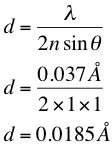Difference between revisions of "Aberrations"
| Line 2: | Line 2: | ||
[[File:Bragg.jpg]] | [[File:Bragg.jpg]] | ||
| + | |||
Where ''n'' is the refractive index of the vacuum (which is equal to 1); ''sinθ'' is equal to 1, since the numerical aperture for an electron microscope is very narrow. | Where ''n'' is the refractive index of the vacuum (which is equal to 1); ''sinθ'' is equal to 1, since the numerical aperture for an electron microscope is very narrow. | ||
| + | |||
However, electromagnetic lens aberrations, particularly from the objective lens, ultimately limit the resolution of the microscope. The typical resolution limit reported for TEM is only about 1 angstrom (about 100 times worse than the theoretical limit). | However, electromagnetic lens aberrations, particularly from the objective lens, ultimately limit the resolution of the microscope. The typical resolution limit reported for TEM is only about 1 angstrom (about 100 times worse than the theoretical limit). | ||
Revision as of 15:47, 4 May 2010
Considering merely the de Broglie wavelength of electrons accelerated at 100kV (a common accelerating voltage for biological-EM), the electron microscope performs dismally compared to how it theoretically could. The wavelength for such and electron is 0.037Å. The theoretical minimum separation, d, that could be resolved with this wavelength is thus (from Bragg's law):
Where n is the refractive index of the vacuum (which is equal to 1); sinθ is equal to 1, since the numerical aperture for an electron microscope is very narrow.
However, electromagnetic lens aberrations, particularly from the objective lens, ultimately limit the resolution of the microscope. The typical resolution limit reported for TEM is only about 1 angstrom (about 100 times worse than the theoretical limit).
